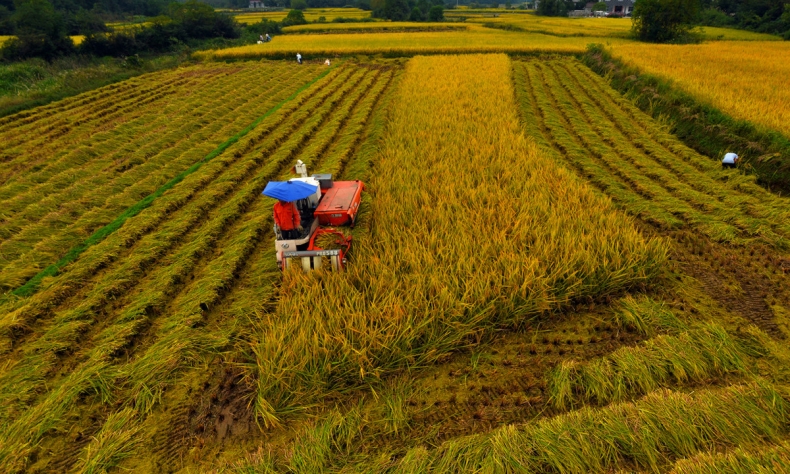
How China’s growth and its relationship to the rest of the world will continue to be an international focus
The 70th anniversary of the founding of the People’s Republic of China (PRC) gives people inside and outside the country a chance to assess what the key achievements of the past decades have been, and where China is heading.
There is little argument about just how divided and impoverished the country was in 1949. It was emerging from decades of wars, with the 1931-45 war against Japanese invasion leading to over 20 million deaths. The civil war from 1946 to 1949 compounded the situation, causing less epic but still significant destruction of what little infrastructure existed and delaying the urgent need to address human development issues.
It is a sobering fact that on the dawn of the foundation of the PRC, life expectancy was 35 years, with about 90 percent of the population living in the countryside. The national rail network was smaller than it had been in the 1920s due to the wars and their impact. There was little proper industrial capacity. It was a country in need of emergency action.

Fast growth
The 1950s saw at least the building blocks to that regeneration put in place. Basic issues like healthcare, literacy and social welfare started to be addressed. The period up to 1976 was a complex one, with a mixture of advances and setbacks, some of which derived from China’s isolated international position for much of this time.
Despite this fact, by the end of the 1970s, life expectancy had risen to double that of the 1940s. If people survived beyond childhood in 1977, it was likely they would live into their 60s or longer, and their standard of living would be higher than it had been three decades before. There were also more infrastructure and industry, and an economy that had been growing for most of the time since the PRC’s establishment.
The year 1978 reset the narrative where development occurred by focusing on things which had been restricted before. Entrepreneurship was allowed through the innovation of township and village enterprises. A market with Chinese characteristics was created, and hugely successful agricultural reforms showed dramatic increases in efficiency and productivity in the 1980s. A non-state sector started to emerge, and growth changed in speed and composition.
Through the 1980s into the 2000s, it was not unusual to see double-digit GDP increases year on year. The per-capita GDP in 1978 was less than $300. By 2009, it had exceeded $3,000. By 2010, when the national census was taken, China had become a place where as many people lived in cities as in the countryside for the first time in its history.
China’s accession into the World Trade Organization (WTO) in 2001 unleashed a wave of productivity that accelerated trends that were already in place. Between 2002 and 2012, the country quadrupled in economic size. Chinese companies became more global in their orientation and more competitive through the competition from multinationals in the domestic market. China’s WTO accession marked the dawn of the era of Global China, a period we are still living in. The impact of all of this on human development has been dramatic, seeing wealth levels, life expectancy and literacy sometimes equal, and in many places overtake, those of developed countries.
In 2019, we now see a country which has been modernized, according to a unique hybrid model. This is recognized in the label “with Chinese characteristics,” which is often attached to ideas like socialism or marketization. According to the World Bank, China’s efforts since 1978 have now helped lift more people out of absolute poverty than any other set of reforms in history. They have also given the country a rich set of experiences about how to create growth, address human development challenges and successfully industrialize.
The 1978 reforms championed by Deng Xiaoping and the top leaders at the time made clear that Chinese socialism was a viable notion and that it could work. Everything that has happened since has shown that this path has been hugely successful in creating high levels of growth, building extraordinary amounts of infrastructure and lifting China to become the world’s second largest economy. Also, its first centenary goal to complete building a moderately prosperous society in all respects is within reach.
Global China
China’s rejuvenation is irreversible, and it is not a remote aspiration, but imminent. It is a part not just of China’s world, but the whole world. We are truly experiencing the period of Global China. When we remember how far the country has had to travel since 1949, this is a remarkable national achievement.
One of the unforeseen challenges of this progress has been that its speed has meant, in many ways, the country is now perhaps 10 or even more years ahead of where it thought it would be even in the 1990s. In the early reform era, the hope was that the country would be able to achieve per-capita GDP levels over $10,000 as early as the middle part of the current century. In fact, China is 30 years ahead of that very early plan. The PRC now has the luxury of dealing with the challenges of success, rather than failure. Even so, there are still challenges.
Fast growth has meant that domestically, the demands of a rising middle class are for soft rather than hard infrastructure. People want high-quality healthcare and public services, and good jobs—the sorts of things middle classes elsewhere in the world desire. They want good housing, a decent natural living environment, quality goods and the chance to travel abroad. The challenge for the government is to keep up with the demands of this immensely important group, while at least remaining realistic about what can be achieved.
Externally, China’s success has surprised many and has sometimes led to misunderstandings. For example, some in the U.S. and Europe see a country they do not fully comprehend and about which they know little suddenly figuring in their lives in ways they never expected. They interpret China as a problem because it is different culturally and politically. Today, in the U.S. in particular, influential figures are endorsing a narrative that sees China’s global reach and power in a negative way.
Because China’s emergence has happened so quickly, it has proven difficult to create an explanatory narrative that at least allays some of these concerns and helps people understand better what China means to them, what Chinese people themselves want and what common ground there is between China and the rest of the world.
The one unassailable fact is that having a country which constitutes a fifth of humanity and a similar proportion of global GDP somehow compartmentalized or divided from everyone else is impossible. The world is part of China and China is part of the world. The urgent task is to create a sustainable framework by which the balance between China and the world, especially the U.S. right now, can be achieved. At the age of 70, the PRC has grown to become a core geopolitical, economic and cultural actor. The coming decades will see the country move into a more complex period where the outcomes will be less dramatic and visible than those which were achieved in the eras before. But the significance will perhaps be even greater.
In 1949, the PRC’s chances of being a global player were remote. Most focused on addressing its stability and domestic challenges. In 2019, that situation has reversed. China’s status as a global actor is assured. The creation of a successful, balanced and sustainable relationship with the outside world will be the key geopolitical issue for the region and the wider world over the coming decades. The implementation of a period of further reform as the country undergoes a transition to a new economic model will also be crucial. These will be the PRC’s focuses as it continues its path to the 100th anniversary of its founding and its second centenary goal in 2049.
The author is an op-ed contributor to Beijing Review and director of the Lau China Institute at King’s College London
 Facebook
Facebook
 Twitter
Twitter
 Linkedin
Linkedin
 Google +
Google +










